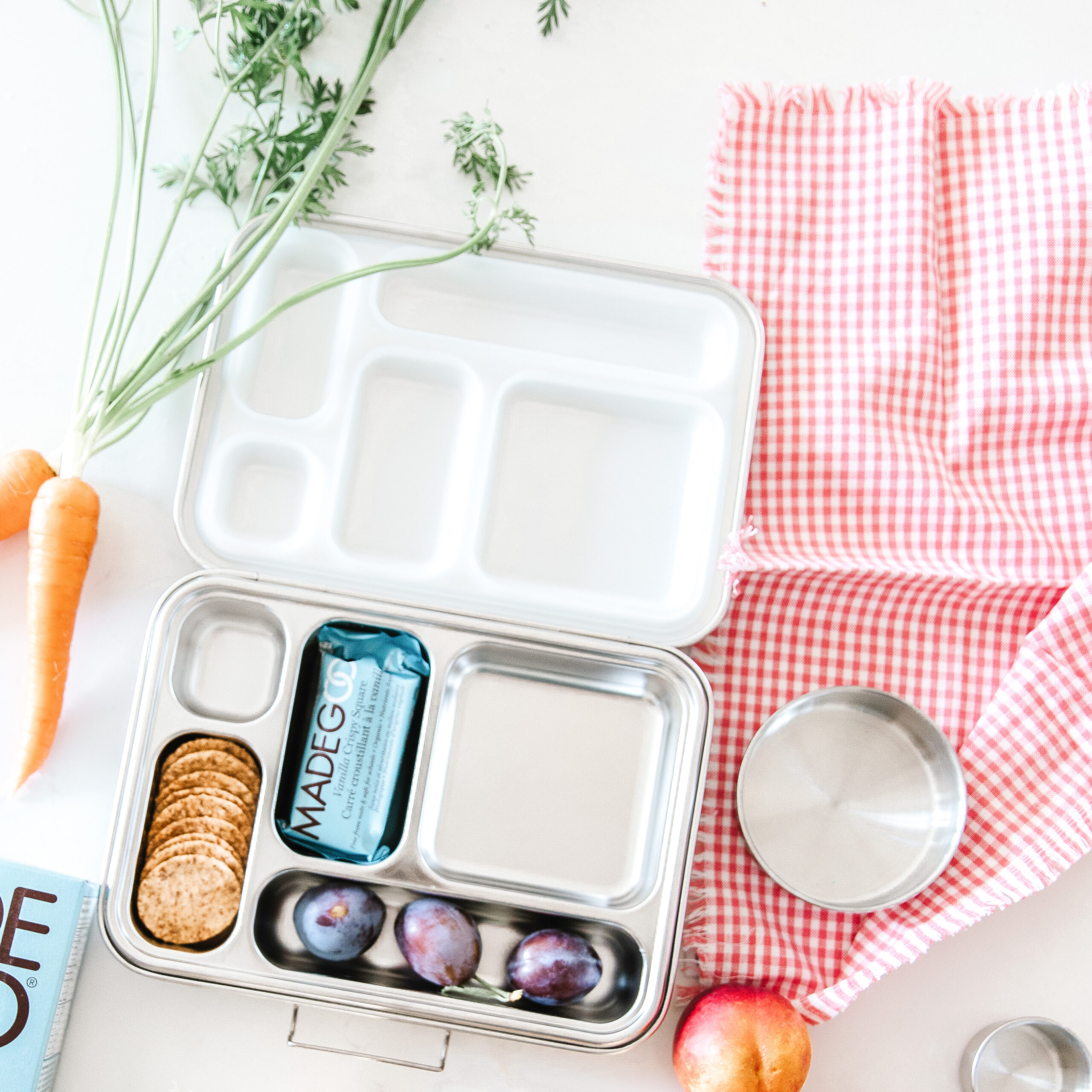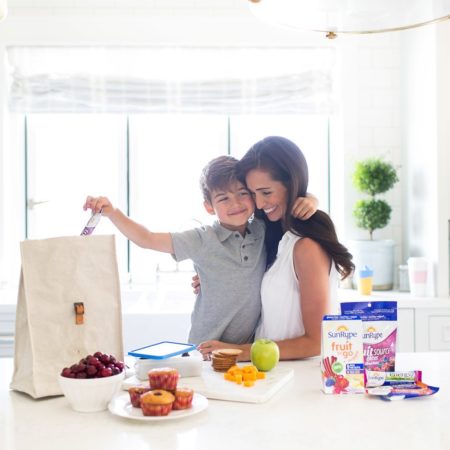Registered Dietitan Sarah Remmer is taking over the blog today! She’s rounded up heaps of school lunch packing tips for picky eaters, including a printable lunchbox packing list (yessss!). Take it away Sarah!

Our kids are back to school and, if you’re anything like me, you’re feeling a bit overwhelmed with getting back into a new routine. School lunch packing (which—let’s be honest—is NOT our most treasured parenting task), activities starting back up, and the unpredictability of another pandemic school year. You’re certainly not alone – we’re all experiencing this chaos to some degree!
What makes school lunch-packing even more daunting? When you have a picky eater. As a pediatric dietitian and mom of 3, I know all about this, both from personal experience (I’ve been there!) and from counselling hundreds of families over the years. Don’t worry – I’ve got you!
School Lunch Packing Tips for Picky Eaters
First off, I’m going to ease your mind by reassuring you that:
- Repetition is ok
- Simplicity is ok
- Some packaged, processed snacks are ok
- Your child won’t love everything you send… and that’s ok.
Phew! In this blog post, I’m going to walk you through my top tips for school lunch success with picky eaters by covering:
- The Division of Responsibility in Feeding (sDOR) and how it applies to school lunches
- What to do if school lunches come home uneaten
- Why using a bento-box is the way to go
- Why you should practice opening containers and jars before school starts
- How to get your kids involved in building their lunch in an age-appropriate way
- My school lunch rule of 5 and why it simplifies everything
The Division of Responsibility in Feeding (sDOR)
If you’re not familiar with the Division of Responsibility in Feeding (sDOR), I would highly recommend that you learn it and give it a try! I can assure you that it’s a total game-changer (it really REALLY works!) and will finally take the stress out of feeding (for everyone).
The sDOR is a brilliant concept developed by Ellyn Satter, a registered dietitian, social worker, and family therapist who runs the non-profit Ellyn Satter Institute in the US. You can learn more at www.ellynsatterinstitute.org. The sDOR distinguishes between the roles of parents and children when it comes to feeding and eating. So, parents are in charge of the what’s, when’s and where’s of feeding, and kids are in charge of if and how much they eat. The sDOR takes the pressure off of both parents and kids and allows kids to eat intuitively, listen to their bodies, learn to love a variety of foods, and establish a long-term healthy relationship with food.
This philosophy is based on the fact that kids are naturally intuitive. If given the chance, they will eat as much as they need, grow in the way that is right for them, and will learn to eat the food their parents eat—that is, if parents fulfill their roles in the sDOR.

How does the sDOR apply to school lunches?
Simply put, you decide what goes into your child’s lunchbox, making sure that there is variety and balance, and then your child decides whether and how much they eat out of it. This might seem obvious, but what I tend to see in my practice is that when children don’t like the foods that their parents send, their parents start to cater to them by sending only foods that the child likes or wants. Although this might seem like the path of least resistance, it doesn’t give kids an opportunity to learn to love new foods. It actually perpetuates picky eating habits! It’s your job as the parent to choose the foods. When it comes to the when and where – that’s taken care of by the school day schedule.

What if their lunch comes home uneaten?!
Ugh. There’s nothing quite as frustrating – I get it! First of all, know that it’s normal and that your child’s overall nutrition likely isn’t affected. Think about it this way: your child’s lunch is a snapshot of what they consume in a week. If you took stock of everything they ate over the period of 7 days, it’s very likely they’re meeting their nutritional requirements! Kids’ eating patterns can be erratic and unpredictable, and are based on SO many factors. We need to trust that they are getting what they need (because they likely are – they don’t need as much as you might think!).
Disciplining a child or getting frustrated at them for not eating their lunch foods might unintentionally shame them, and/or deter them even more from eating their lunch foods. Even though it’s frustrating, wasteful, and sometimes worrisome, we need to keep our child’s long-term relationship with food as the top priority. We want our kids to have positive experiences with food, regardless if they eat it or not.
So, instead of reacting negatively, get curious…
- Has their growth slowed and is their appetite smaller right now?
- Did they have a really filling breakfast or dinner the night before?
- Could they be distracted at lunchtime?
- How much time do they get at lunchtime and am I sending things that take longer to eat?
- Can they open their containers and unscrew their lids?
- Is there food at a temperature that they like?
- Did I send the right utensils?
- Are they bored with the items I’m sending?
- Do they feel as though they have no say in what is sent?
- Are they not feeling well (is there tummy hurting at school? Could this be due to anxiety?)
- Is there food messy or unappealing by the time lunch rolls around?
Calmly sit down with your child and ask them how they’re feeling about their school lunch and why it comes back uneaten. You might be surprised at the answer! And the solution might be super simple.

Should they have to eat their lunch leftovers for their after-school snack?
As the parent, you get to decide what your mealtime boundaries and rules are. Every family is unique and has different circumstances. One thing we want to be careful with though, is not making our child feel that they are being punished for not eating their school lunch. By limiting after school snack options to school lunch leftovers, your child will likely feel this way, AND it may present a food safety hazard because their perishable food is no longer at a safe temperature. My suggestion? Offer a different after school snack if you can, and then troubleshoot together on how you can both make school lunches more appealing and easier to eat.

Tips to Help Your Picky Eater
Here are five tips that might help your picky eater have more success with school lunches.
1. Try a bento-box:
You can find these everywhere now. A bento box allows you to separate foods into their own compartments (most kids don’t like their foods touching, especially if they’re going through a picky eating phase!), offers opportunity for lots of variety and colour (the more options and variety, the more your child will eat overall – think about how people eat at a buffet!), AND it’s better for the environment because you don’t have to use as many baggies or as much plastic wrap.

2. Practice opening items with your child:
This sounds silly, but it’s really important! Your child might not be eating much because they can’t get into it in the first place!
3. Get kids involved:
Although you’re ultimately in charge of what is packed in their school lunches (remember the sDOR), offer some structured choice (see my “rule of 5” below). For example, you can offer your younger children (under 7) two choices for their fruit “would you like a nectarine or would you like grapes tomorrow for lunch?”. If your kids are at the age that they can pack their own lunches independently (around ages 7-8 and older), you can teach them about the rule of five, and have options from each category for them to choose from. Getting kids involves and allowing them to have a bit of control, will increase the chances of them eating more of their lunch.
4. Follow the lunchbox ‘rule of 5’:
The rule of 5 means that there are at least 5 items in your child’s lunch for balance:
- Vegetable (pack at least one)
Examples:
-
-
- Raw veggies, cut up
- Leafy greens (ie. salad)
- Frozen veggies (eg. peas)
- Cooked vegetables
- Homemade salsa or bruschetta
- Vegetable soup
-
- Fruit (pack at least one)
Examples:
-
-
- Piece or fresh fruit
- Berries
- Unsweetened canned fruit (canned in water)
- Unsweetened fruit and veggie purees
- Unsweetened dried fruit
-
- Protein-rich foods (pack two)
Examples:
-
-
- Leftover meat, poultry, fish
- Canned fish
- Eggs
- Milk
- Yogurt or Greek yogurt
- Cottage cheese
- Cheese
- Beans/Lentils
- Seeds or seed butter
- Tofu or tempeh
-
- Whole grain or starchy vegetable (include at least one)
Examples:
-
-
- Whole grain bread, tortilla or pita
- Whole grain crackers
- Whole grain homemade granola bar or oat-based energy bites
- Homemade muffin or loaf made with whole grain flour or oats
- Oatmeal
- Whole grain pancake, waffle or French toast
- Leftover brown rice, quinoa, barley
- Corn
- Potatoes/sweet potatoes/yams
-
If you build school lunches with this rule of five in mind (and add a treat for fun if you want!), and it will all just seem a bit simpler.

Lunchbox Packing List
I hope that this post both gives you some peace of mind and makes school lunch packing a little bit easier! Looking for more information on how to navigate picky eating and school lunches? Make sure to pick up a copy of my new book (that I co-authored with fellow Dietitian Cara Rosenbloom, RD), Food to Grow On: The Ultimate Guide to Childhood Nutrition, From Pregnancy to Packed Lunches. There is an entire section on picky eating, a chapter on school nutrition and delicious and kid-friendly recipes throughout!
I’ve also got an on-demand, online Program for parents called Mealtimes Solved that is geared towards parent of kids from preschool to pre-teen. It covers everything you need to know about feeding your kids, including picky eating, weight struggles, body image issues, school nutrition and much more!
Thank you to Sarah Remmer for writing this blog post!







Love this post, getting the kids ready for kindergarten and found this so helpful! Do I spy The Good Kind bento boxes? Do you happen to have a promo code for those?
Hi Sarah! Thanks so much – yes it is, but I don’t have a code unfortunately. They really are awesome!